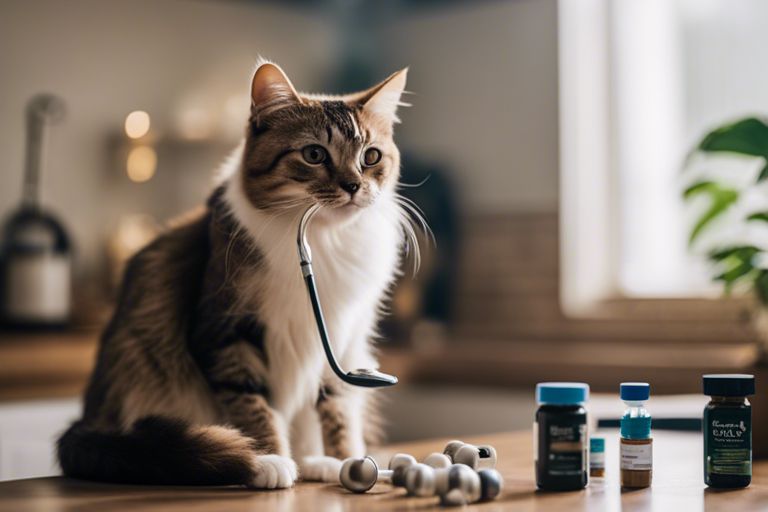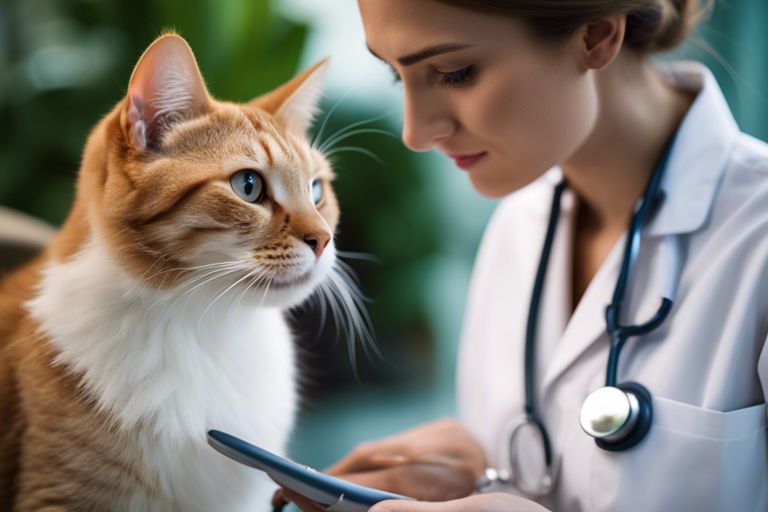If you have noticed that your feline friend is acting lethargic, weak, or has pale gums, they may be showing signs of anemia. Anemia in cats is a serious condition that can be caused by a variety of factors such as blood loss, nutritional deficiencies, or underlying health issues. Other symptoms to watch out for include rapid breathing, decreased appetite, and jaundice. If you suspect that your cat may be anemic, it is crucial to seek veterinary care immediately. Anemia can lead to severe complications and even be life-threatening if left untreated. Your vet can perform diagnostic tests to determine the cause of the anemia and provide the appropriate treatment to help your cat recover.
Key Takeaways:
- Lethargy: Anemic cats may appear weak and tired, with a lack of energy or enthusiasm for play or activity.
- Pale gums: Cats with anemia may have pale or white gums, indicating a lack of healthy red blood cells.
- Rapid breathing: Anemic cats may exhibit rapid or labored breathing, as their bodies struggle to obtain enough oxygen.
- Decreased appetite: Anemia can cause a loss of appetite in cats, leading to weight loss and reduced overall health.
- Jaundice: In severe cases, cats with anemia may develop yellowing of the skin, eyes, or gums due to a buildup of bilirubin.
Understanding Anemia in Cats
Clearly, understanding the symptoms, causes, and types of anemia in cats is essential for providing them with the best care and treatment. Anemia is a condition in which there is a lower than normal number of red blood cells or hemoglobin in the blood, leading to reduced oxygen supply to the body’s tissues and organs.
Definition and Types of Anemia
Anemia in cats can be caused by various factors such as nutritional deficiencies, chronic diseases, parasitic infections, and bone marrow disorders. There are different types of anemia, including regenerative anemia and non-regenerative anemia.
- Nutritional deficiencies: Lack of essential nutrients such as iron, vitamin B12, and folic acid can lead to anemia in cats.
- Chronic diseases: Conditions such as kidney disease, cancer, or autoimmune disorders can cause anemia in cats.
- Parasitic infections: Blood-sucking parasites such as fleas, ticks, and intestinal worms can lead to anemia in cats.
- Bone marrow disorders: Diseases or disorders affecting the bone marrow’s ability to produce red blood cells can result in anemia.
- Recognizing the type of anemia your cat is experiencing can help your veterinarian determine the underlying cause and the most effective treatment plan.
Causes of Anemia in Felines
Anemia in cats can be caused by a variety of factors, including kidney disease, blood loss, toxins or poisons, and inherited disorders. Kidney disease can lead to a decrease in the production of erythropoietin, a hormone that stimulates red blood cell production, causing anemia. Blood loss from an injury, surgery, or parasitic infestation can also result in anemia. Additionally, ingestion of toxins such as certain medications, plants, or chemicals can cause damage to red blood cells and lead to anemia. Inherited disorders such as hemophilia or autoimmune hemolytic anemia can also predispose cats to developing anemia. It is important to identify the underlying cause of anemia in your cat to ensure appropriate treatment and management of the condition.

Recognizing the Symptoms
One of the most important things as a cat owner is to be able to recognize the symptoms of anemia in your feline friend. Anemia is a condition in which there is a lower-than-normal number of red blood cells in the body, leading to reduced oxygen delivery to tissues. This can be caused by a range of underlying health issues, so it’s crucial to be aware of the signs that your cat may be suffering from anemia.
Physical Indicators of Anemia
When it comes to physical indicators, you should pay attention to pale gums and tongue in your cat, as well as weakness and lethargy. You may also notice rapid breathing and an increased heart rate. Your cat may also seem more prone to infection and may have persistent digestive issues. These physical signs can indicate that your cat is experiencing a lack of red blood cells and may be anemic.
Behavioral Changes Related to Anemia
Aside from physical symptoms, there are also behavioral changes that could point to anemia in your cat. You may notice that your cat is less active and playful than usual or seems disinterested in their surroundings. You might also observe that your cat has poor grooming habits and a lackluster coat. These changes in behavior can be an indication that your cat is not feeling well and could be suffering from anemia.
Diagnosis and Treatment
Now that you are aware of the symptoms of anemia in cats, let’s discuss the important aspects of diagnosing and treating this condition. It is crucial to seek professional help from a veterinarian if you suspect that your cat is anemic. Anemia can be a symptom of an underlying health issue that needs to be diagnosed and treated as soon as possible to prevent further complications.
Veterinary Diagnostic Methods
When you take your cat to the veterinarian, they will perform a thorough physical examination and may also recommend blood tests to determine the level of red blood cells and hemoglobin in your cat’s blood. These tests will help determine the severity of anemia and identify the underlying cause, whether it is due to blood loss, nutritional deficiencies, or a chronic disease. In some cases, additional diagnostic procedures, such as imaging or bone marrow evaluation, may be necessary to determine the cause of anemia.
Treatment Options for Anemic Cats
The treatment for anemia in cats will depend on the underlying cause and the severity of the condition. Your veterinarian may recommend a dietary change to include more iron-rich foods, vitamin supplements, or medications to address any underlying health issues. In cases of severe anemia, blood transfusions may be necessary to quickly restore your cat’s red blood cell count. It is important to follow your veterinarian’s recommendations for treatment and closely monitor your cat’s progress to ensure a successful recovery.
Remember, early diagnosis and treatment of anemia in cats are crucial for their well-being. Your prompt action and close collaboration with your veterinarian will give your cat the best chance for a successful recovery from this condition.
Prevention and Management
Unlike humans, cats with anemia can’t simply pop an iron supplement to improve their condition. However, there are steps you can take to prevent anemia in your cat and manage the condition if it does arise. To learn more about managing anemia in cats, visit Anemia in Cats.
Preventing Anemia in Cats
One of the most important steps you can take to prevent anemia in your cat is to ensure they receive a balanced and nutritious diet. Anemia can sometimes be caused by a lack of essential nutrients, such as iron, vitamin B12, and folic acid, so providing high-quality commercial cat food or a balanced homemade diet is essential. Additionally, make sure your cat receives regular veterinary check-ups to catch any potential health issues before they become severe.
Long-Term Management Strategies
If your cat is diagnosed with anemia, your veterinarian will recommend long-term management strategies based on the underlying cause of their condition. This may include dietary changes, medications, or even surgery in some cases. Monitoring your cat’s progress and following your vet’s recommendations is crucial for managing their condition. Additionally, providing a stress-free environment, regular exercise, and plenty of mental stimulation can also help support your cat’s overall health and aid in their recovery.
Conclusion
Ultimately, it is important to pay attention to your cat’s behavior and be on the lookout for the symptoms of anemia. If you notice any signs such as pale gums, weakness, lethargy, or loss of appetite, it is crucial to seek veterinary care as soon as possible. Anemia can be a serious condition that requires prompt diagnosis and treatment. By being aware of the symptoms and seeking timely medical attention, you can help ensure the health and well-being of your feline companion. Remember to always consult with a veterinarian for any concerns regarding your cat’s health.
FAQ
Q: What are the symptoms of anemia in cats?
A: The symptoms of anemia in cats can include pale gums, lethargy, weakness, loss of appetite, and rapid breathing. It’s important to consult with a veterinarian if you notice these signs in your cat.
Q: Can anemia in cats be a serious health concern?
A: Yes, anemia in cats can be a serious health concern, especially if left untreated. It can be a sign of underlying health issues such as infections, autoimmune diseases, or parasites. It’s crucial to seek veterinary care to determine the cause and appropriate treatment.
Q: How is anemia in cats diagnosed and treated?
A: Anemia in cats is diagnosed through a physical examination, blood tests, and sometimes additional diagnostic imaging. Treatment may involve addressing the underlying cause, such as administering medication for parasites or managing chronic diseases. In severe cases, blood transfusions may be necessary to stabilize the cat’s condition.

Jayley, a devoted cat enthusiast, also writer for other cat blog as well. She aims to dedicated to providing comprehensive information, insights, and advice on everything you’d ever want to know about our whiskered companions.
